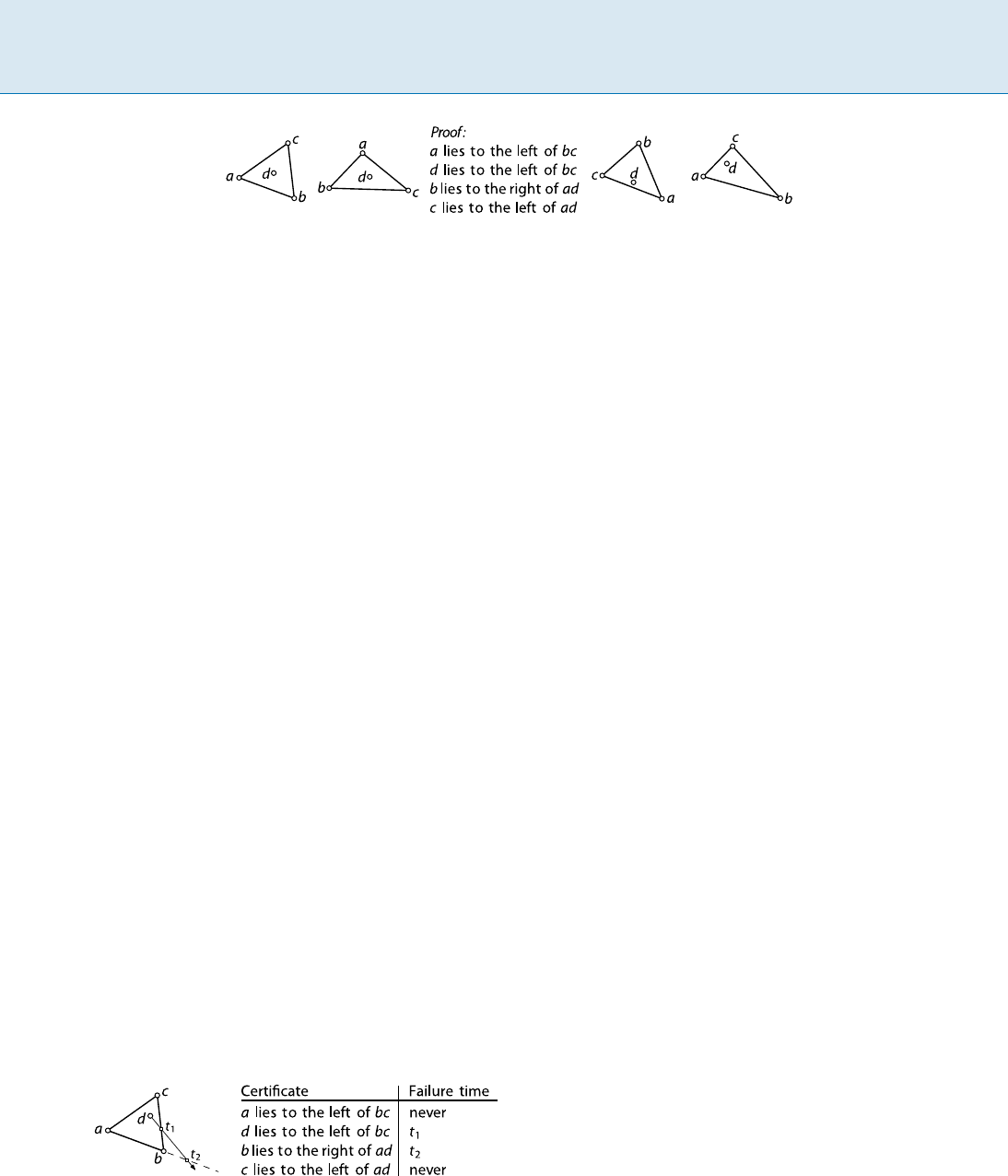Kao M.-Y. (ed.) Encyclopedia of Algorithms
Подождите немного. Документ загружается.


418 K Kinetic Data Structures
Kinetic Data Structures, Figure 2
Equivalent convex hull configurations (left and right), a proof that a; b; and c form the convex hull of S (center)
the failure time of a certificate can be computed as the next
largest root of an algebraic expression. An important as-
pect of kinetic data structures is their on-line character:
although the positions and motions (flight plans) of the
objects are known at all times, they are not necessarily
known far in advance. In particular, any object can change
its flight plan at any time. A good KDS should be able to
handle such changes in flight plans efficiently.
A detailed introduction to kinetic data structures can
be found in Basch’s Ph. D. thesis [1] or in the surveys by
Guibas [3,4]. In the following the principles behind kinetic
data structures are illustrated by an easy example.
Consider a KDS that maintains the convex hull of a set
S of four points a; b; c; and d as depicted in Fig. 2.Asetof
four simple certificates is sufficient to certify that a; b; and
c form indeed the convex hull of S (see Fig. 2 center). This
implies, that the convex hull of S will not change under
any motion of the points that does not lead to a violation
of these certificates. To put it differently, if the points move
along trajectories that move them between the configura-
tions depicted in Fig. 2 without the point d ever appear-
ing on the convex hull, then the KDS in principle does not
have to process a single event.
Now consider a setting in which the points a; b; and
c are stationary and the point d moves along a linear tra-
jectory (Fig. 3 left). Here the KDS has exactly two events
to process. At time t
1
the certificate “d is to the left of bc”
failsasthepointd appears on the convex hull. In this easy
setting, only the failed certificate is replaced by “d is to the
right of bc” with failure time “never”, generally processing
an event would lead to the scheduling and descheduling of
several events from the event queue. Finally at time t
2
the
certificates “b is to the right of ad” fails as the point b ceases
Kinetic Data Structures, Figure 3
Certificate structure for points a; b; and c being stationary and
point d moving along a straight line
to be on the convex hull and is replaced by “b is to the left
of ad” with failure time “never.”
Kinetic data structures and their accompanying main-
tenance algorithms can be evaluated and compared with
respect to four desired characteristics.
Responsiveness. One of the most important performance
measures for a KDS is the time needed to update the
attribute and to repair the certificate set when a certifi-
cate fails. A KDS is called responsive if this update time
is “small”, that is, polylogarithmic.
Compactness. A KDS is called compact if the number of
certificates is near-linear in the total number of objects.
Note that this is not necessarily the same as the amount
of storage the entire structure needs.
Locality. A KDS is called local if every object is involved
in only a small number of certificates (again, “small”
translates to polylogarithmic). This is important when-
ever an object changes its flight plane, because one has
to recompute the failure times of all certificates this ob-
ject is involved in, and update the event queue accord-
ingly. Note that a local KDS is always compact, but that
the reverse is not necessarily true.
Efficiency. A certificate failure does not automatically im-
ply a change in the attribute that is being maintained, it
can also be an internal event, that is, a change in some
auxiliary structure that the KDS maintains. A KDS is
called efficient if the worst-case number of events han-
dled by the data structure for a given motion is small
compared to the number of combinatorial changes of
the attribute (external events)thatmustbehandledfor
that motion.
Applications
The paper by Basch et al. [2] sparked a large amount
of research activities and over the last years kinetic data
structures have been used to solve various dynamic com-
putational geometry problems. A number of papers deal
foremost with the maintenance of discrete attributes for
sets of moving points, like the closest pair, width and di-
ameter, clusters, minimum spanning trees, or the con-
strained Delaunay triangulation. Motivated by ad hoc mo-
bile networks, there have also been a number of papers that

Knapsack K 419
show how to maintain the connected components in a set
of moving regions in the plane. Major research efforts have
also been seen in the study of kinetic binary space parti-
tions (BSPs) and kinetic kd-trees for various objects. Fi-
nally, there are several papers that develop KDSs for colli-
sion detection in the plane and in three dimensions. A de-
tailed discussion and an extensive list of references can be
found in the survey by Guibas [4].
Cross References
Fully Dynamic Minimum Spanning Trees
Minimum Geometric Spanning Trees
Recommended Reading
1. Basch, J.: Kinetic Data Structures. Ph. D. thesis, Stanford Univer-
sity (1999)
2. Basch, J., Guibas, L., Hershberger, J.: Data structures for mobile
data.J.Algorithms31, 1–28 (1999)
3. Guibas, L.: Kinetic data structures: A state of the art report. In:
Proc. 3rd Workshop on Algorithmic Foundations of Robotics,
pp. 191–209 (1998)
4. Guibas, L.: Modeling Motion. In: Goodman, J., O’Rourke, J.: (eds),
Handbook of Discrete and Computational Geometry. CRC Press,
2nd ed. (2004)
Knapsack
1975; Ibarra, Kim
HANS KELLERER
Department of Computer Science, University of Graz,
Graz, Austria
Keywords and Synonyms
Approximation algorithm; Fully polynomial time approx-
imation scheme (FPTAS)
Problem Definition
For a given set of items N = f1;:::;ng with nonnegative
integer weights w
j
and profits p
j
, j =1;:::;n, and a knap-
sack of capacity c,theknapsack problem (KP) is to se-
lect a subset of the items such that the total profit of the
selected items is maximized and the corresponding total
weight does not exceed the knapsack capacity c.
Alternatively, a knapsack problem can be formulated
as a solution of the following linear integer programming
formulation:
(KP) maximize
n
X
j=1
p
j
x
j
(1)
subject to
n
X
j=1
w
j
x
j
c ; (2)
x
j
2f0; 1g; j =1;:::;n : (3)
The knapsack problem is the simplest non-trivial inte-
ger programming model having binary variables, only
a single constraint and only positive coefficients. A large
number of theoretical and practical papers has been pub-
lished on this problem and its extensions. An extensive
overview can be found in the books by Kellerer, Pferschy
and Pisinger [2] or Martello and Toth [7].
Adding the integrality condition (3) to the simple lin-
ear program (1)-(2) already puts (KP) into the class of
NP-hard problems. Thus, (KP) admits no polynomial
time algorithms unless
P = NPholds.
Therefore, this entry will focus on approximation al-
gorithms for (KP). A common method to judge the qual-
ity of an approximation algorithm is its worst-case perfor-
mance. For a given instance I define by z
(I)theoptimal
solution value of (KP) and by z
H
(I) the corresponding so-
lution value of a heuristic H.For" 2 [0; 1[ a heuristic H
is called a (1 ")–approximation algorithm for (KP) if for
any instance I
z
H
(I) (1 ")z
(I)
holds. Given a parameter ",aheuristicH is called a fully
polynomial approximation scheme,oranFTPAS,ifH
is a (1 ")–approximation algorithm for (KP) for any
" 2 [0; 1[, and its running time is polynomial both in the
length of the encoded input n and 1/".ThefirstFTPASfor
(KP) was suggested by Ibarra and Kim [1] in 1975. It was
among the early FPTASes for discrete optimization prob-
lems. It will be described in detail in the following.
Key Results
(KP) can be solved in pseudopolynomial time by a sim-
ple dynamic programming algorithm. One possible vari-
ant is the so-called dynamic programming by profits (DP-
Profits). The main idea of DP-Profits is to reach every pos-
sible total profit value with a subset of items of minimal
total weight. Clearly, the highest total profit value, which
can be reached by a subset of weight not greater than the
capacity c, will be an optimal solution.
Let y
j
(q) denote the minimal weight of a subset of
items from f1;:::; jgwith total profit equal to q.Tobound
the length of every array y
j
an upper bound u on the opti-
mal solution value has to be computed. An obvious pos-
sibility would be to use the upper bound U
LP
=
z
LP
˘
from the solution z
LP
of the LP-relaxation of (KP) and set

420 K Knapsack
U := U
LP
.ItcanbeshownthatU
LP
is at most twice as large
as the optimal solution value z
*
. Initializing y
0
(0) := 0
and y
0
(q):=c +1forq =1;:::;U, all other values can be
computed for j =1;:::;n and q =0;:::;U by using the
recursion
y
j
(q):=
(
y
j1
(q)ifq < p
j
;
minfy
j1
(q); y
j1
(q p
j
)+w
j
g if q p
j
:
The optimal solution value is given by maxfq j y
n
(q) cg
and the running time of DP-Profits is bounded by O(nU).
Theorem 1 (Ibarra, Kim) There is an FTPAS for (KP)
which runs in O(n log n + n/"
2
) time.
Proof The FTPAS is based on appropriate scaling of
the profit values p
j
and then running DP-Profits with the
scaled profit values. Scaling means here that the given
profit values p
j
are replaced by new profits
˜
p
j
such that
˜
p
j
:=
j
p
j
K
k
foranappropriatechosenconstantK.
This scaling can be seen as a partitioning of the
profit range into intervals of length K with starting points
0; K; 2K;:::. Naturally, for every profit value p
j
there is
some integer value i 0suchthatp
j
falls into the inter-
val [iK; (i +1)K[. The scaling procedure generates for ev-
ery p
j
the value
˜
p
j
as the corresponding index i of the lower
interval bound iK.
Running DP-Profits yields a solution set
˜
X for the
scaled items which will usually be different from the origi-
nal optimal solution set X
*
. Evaluating the original profits
of item set
˜
X yieldstheapproximatesolutionvaluez
H
.The
difference between z
H
and the optimal solution value can
be bounded as follows.
z
H
X
j2
˜
X
K
p
j
K
X
j2X
K
p
j
K
X
j2X
K
p
j
K
1
= z
jX
jK:
To get the desired performance guarantee of 1 " it is suf-
ficient to have
z
z
H
z
jX
jK
z
":
To ensure this K has to be choosen such that
K
"z
jX
j
: (4)
Since n jX
j and U
LP
/2 z
choosing K :=
"U
LP
2n
satisfies condition (4) and thus guarantees the perfor-
mance ratio of 1 ". Substituting U in the O(nU)bound
for DP-Profits by U/K yields an overall running time of
O(n
2
").
A further improvement in the running time is ob-
tained in the following way. Separate the items into small
items (having profit
"
2
U
LP
)andlarge items (having
profit >
"
2
U
LP
). Then, perform DP-Profits for the scaled
large items only. To each entry q of the obtained dynamic
programming array with corresponding weight y(q)the
small items are added to a knapsack with residual capacity
c y(q) in a greedy way. The small items shall be sorted
in non-increasing order of their profit to weight ratio. Out
of the resulting combined profit values, the highest one is
selected. Since every optimal solution contains at most 2/"
large items, jX
jcan be replaced in (4)by2/" which results
in an overall running time O(n log n + n/"
2
). The memory
requirement of the algorithm is O(n +1/"
3
).
Two important approximation schemes with advanced
treatment of items and algorithmic fine tuning were pre-
sented some years later. The classical paper by Lawler [5]
gives a refined scaling resp. partitioning of the items
and several other algorithmic improvements which re-
sults in a running time O(n log(1/")+1/"
4
). A second pa-
per by Magazine and Oguz [6] contains among other fea-
tures a partitioning and recombination technique to re-
duce the space requirements of the dynamic programming
procedure. The fastest algorithm is due to Kellerer and
Pferschy [3,4] with running time O(n minflog n; log(1/")g
+1/"
2
log(1/") minfn; 1/" log(1/")g)andspacerequire-
ment O(n +1/"
2
).
Applications
(KP) is one the classical problems in combinatorial opti-
mization. Since (KP) has this simple structure and since
there are efficient algorithms for solving it, many solution
methods of more complex problems employ the knapsack
problem (sometimes iteratively) as a subproblem.
A straightforward interpretation of (KP) is an invest-
ment problem. A wealthy individual or institutional in-
vestor has a certain amount of money c available which
he wants to put into profitable business projects. As a ba-
sis for his decisions he compiles a long list of possible
investments including for every investment the required
amount w
j
and the expected net return p
j
over a fixed pe-
riod. The aspect of risk is not explicitly taken into account
here. Obviously, the combination of the binary decisions
for every investment such that the overall return on in-
vestment is as large as possible can be formulated by (KP).
One may also view the (KP) as a “cutting” problem.
Assume that a sawmill has to cut a log into shorter pieces.
The pieces must however be cut into some predefined
standard-lengths w
j
, where each length has an associated
selling price p
j
. In order to maximize the profit of the log,
the sawmill can formulate the problem as a (KP) where the
length of the log defines the capacity c.

Knapsack K 421
Among the wide range of “real world” applications
shall be mentioned two-dimensional cutting problems,
column generation, separation of cover inequalities, fi-
nancial decision problems, asset-backed securitization,
scheduling problems, knapsack cryptosystems and most
recent combinatorial auctions. For a survey on applica-
tions of knapsack problems the reader is referred to [2].
Recommended Reading
1. Ibarra, O.H., Kim, C.E.: Fast approximation algorithms for the
knapsack and sum of subset problem. J. ACM 22, 463–468
(1975)
2. Kellerer, H., Pisinger, D., Pferschy U.: Knapsack Problems.
Springer, Berlin (2004)
3. Kellerer, H., Pferschy, U.: A new fully polynomial time approxi-
mation scheme for the knapsack problem. J. Comb. Optim. 3,
59–71 (1999)
4. Kellerer, H., Pferschy, U.: Improved dynamic programming in
connection with an FPTAS for the knapsack problem. J. Comb.
Optim. 8, 5-11 (2004)
5. Lawler, E.L.: Fast approximation algorithms for knapsack prob-
lems. Math. Oper. Res. 4, 339–356 (1979)
6. Magazine, M.J., Oguz, O.: A fully polynomial approximation al-
gorithm for the 0–1 knapsack problem. Eur. J. Oper. Res. 8, 270–
273 (1981)
7. Martello, S., Toth, P. Knapsack Problems: Algorithms and Com-
puter Implementations. Wiley, Chichester (1990)

Learning with the Aid of an Oracle L 423
L
Learning with the Aid of an Oracle
1996; Bshouty, Cleve, Gavaldà, Kannan, Tamon
CHRISTINO TAMON
Department of Mathematics and Computer Science,
Clarkson University,
Potsdam, NY, USA
Keywords and Synonyms
Oracles and queries that are sufficient for exact learning
Problem Definition
In the exact learning model of Angluin [1], a learning algo-
rithm A must discover an unknown function f: f0; 1g
n
!
f0; 1gthat is a member of a known class C of Boolean func-
tions. The learning algorithm can make at least one of the
following types of queries about f:
Equivalence query EQ
f
(g), for a candidate function g:
The reply is either “yes”, if g , f,oracounterexample
a with g(a) ¤ f(a), otherwise.
Membership query MQ
f
(a), for some a 2f0; 1g
n
:The
reply is the Boolean value f(a).
Subset query SubQ
f
(g), for a candidate function g:The
reply is “yes”, if g ) f,oracounterexamplea with
f(a) < g(a), otherwise.
Superset query SupQ
f
(g), for a candidate function g:
The reply is “yes”, if f ) g,oracounterexamplea with
g(a) < f(a), otherwise.
A Disjunctive Normal Formula (DNF)isadepth-2OR-
AND circuit whose size is given by the number of its AND
gates. Likewise, a Conjunctive Normal Formula (CNF)is
adepth-2AND-OR circuit whose size is given by the num-
ber of its OR gates. Any Boolean function can be repre-
sented as both a DNF or a CNF formula. A k-DNF is a DNF
where each AND gate has a fan-in of at most k; similarly, it
is possible to define k-CNF.
Problem
For a given class C of Boolean functions, such as poly-
nomial-size Boolean circuits or Disjunctive Normal Form
(DNF) formulas, the goal is to design polynomial-time
learning algorithms for any unknown f 2 C and ask a poly-
nomial number of queries. The output of the learning al-
gorithm should be a function g of polynomial size satisfy-
ing g , f . The polynomial functions bounding the run-
ning time, query complexity, and output size are defined in
terms of the number of inputs n and the size of the smallest
representation (Boolean circuit or DNF) of the unknown
function f
Key Results
One of the main results proved in [4] is that Boolean cir-
cuits and Disjunctive Normal Formulas are exactly learn-
able using equivalence queries and access to an NP oracle.
Theorem 1 The following tasks can be accomplished with
probabilistic polynomial-time algorithms that have access
to an NP oracle and make polynomially many equivalence
queries:
Learning DNF formulas of size s using equivalence
queries that are depth-3 AND-OR-AND formulas of size
O(sn
2
/log
2
n).
Learning Boolean circuits of size s using equivalence
queries that are circuits of size O(sn + n log n).
The idea behind this result is simple. Any class C of
Boolean functions is exactly learnable with equivalence
queries using the Halving algorithm of Littlestone [10].
This algorithm asks equivalence queries that are the ma-
jority of candidate functions from C.Thesearefunctions
in C that are consistent with the counterexamples obtained
so far by the learning algorithm. Since each such major-
ity query eliminates at least half of the candidate func-
tions, log
2
jCj equivalence queries are sufficient to learn
any function in C. A problem with using the Halving al-

424 L Learning with the Aid of an Oracle
gorithm here is that the majority query has exponential
size. But, it can be shown that a majority of a polyno-
mial number of uniformly random candidate functions
is a good enough approximator to the majority of all
candidate functions. Moreover, with access to an NP or-
acle, there is a randomized polynomial time algorithm
for generating random uniform candidate functions due
to Jerrum, Valiant, and Vazirani [6]. This yields the re-
sult.
The next observation is that subset and superset
queries are apparently powerful enough to simulate both
equivalence queries and the NP oracle. This is easy
to see since the tautology test g , 1isequivalentto
SubQ
f
(g) ^ SubQ
f
(g), for any unknown function f;and,
EQ
f
(g)isequivalenttoSubQ
f
(g) ^ SupQ
f
(g). Thus, the
following generalization of Theorem 1 is obtained.
Theorem 2 The following tasks can be accomplished with
probabilistic polynomial-time algorithms that make poly-
nomially many subset and superset queries:
Learning DNF formulas of size s using equivalence
queries that are depth-3 AND-OR-AND formulas of size
O(sn
2
/log
2
n).
Learning Boolean circuits of size s using equivalence
queries that are circuits of size O(sn + n log n).
Stronger deterministic results are obtained by allowing
more powerful complexity-theoretic oracles. The first of
these results employ techniques developed by Sipser and
Stockmeyer [11,12].
Theorem 3 The following tasks can be accomplished with
deterministic polynomial-time algorithms that have access
to an ˙
p
3
oracle and make polynomially many equivalence
queries:
Learning DNF formulas of size s using equivalence
queries that are depth-3 AND-OR-AND formulas of size
O(sn
2
/log
2
n).
Learning Boolean circuits of size s using equivalence
queries that are circuits of size O(sn + n log n).
In the following result, C is an infinite class of functions
containing functions of the form f : f0; 1g
?
!f0; 1g.The
class C is p-evaluatable if the following tasks can be per-
formed in polynomial time:
Given y,isy a valid representation for any function
f
y
2 C?
Given a valid representation y and x 2f0; 1g
?
,is
f
y
(x)=1?
Theorem 4 Let C be any p-evaluatable class. The following
statements are equivalent:
C is learnable from polynomially many equivalence
queries of polynomial size (and unlimited computa-
tional power).
C is learnable in deterministic polynomial time with
equivalence queries and access to a ˙
p
5
oracle.
For exact learning with membership queries, the following
results are proved.
Theorem 5 The following tasks can be accomplished with
deterministic polynomial-time algorithms that have access
to an NP oracle and make polynomially many membership
queries (in n, DNF and CNF sizes of f,wheref is the un-
known function):
Learning monotone Boolean functions.
Learning O(log n) CNF
T
O(log n) DNF.
Theideasbehindtheaboveresultusetechniques
from [1,3]. For a monotone Boolean function f,thestan-
dard closure algorithm uses both equivalence and mem-
bership queries to learn f using candidate functions g sat-
isfying g ) f. The need for membership can be removed
using the following observation. Viewing :f as a mono-
tone function on the inverted lattice, it is possible to learn
f and :f simultaneously using candidate functions g,h,re-
spectively, that satisfy g ) h.TheNP oracle is used to ob-
tain an example a that either helps in learning f or in learn-
ing :f;whennosuchexamplecanbefound,f was learned.
Theorem 6 Any class C of Boolean functions that is ex-
actly learnable using a polynomial number of member-
ship queries (and unlimited computational power) is exactly
learnable in expected polynomial time using a polynomial
number of membership queries and access to an NP oracle.
Moreover, any p-evaluatable class C that is exactly
learnable from a polynomially number membership queries
(and unlimited computational power), is also learnable in
deterministic polynomial time using a polynomial number
of membership queries and access to a ˙
p
5
oracle.
Theorems 4 and 6 showed that information-theoretic
learnability using equivalence and membership queries
can be transformed into computational learnability at the
expense of using the ˙
p
5
and NP oracles, respectively.
Applications
The learning algorithm for Boolean circuits using equiv-
alence queries and access to an NP oracle has found
an application in complexity theory. Watanabe (see [9])
showed an improvement on a known theorem of Karp

Learning Automata L 425
and Lipton [7]: if NP has polynomial-size circuits, then the
polynomial-time hierarchy PH collapses to ZPP
NP
.
Some techniques developed in Theorem 5 for exact
learning using membership queries of monotone Boolean
functions have found applications in data mining [5].
Open Problems
It is unknown if there are polynomial-time learning algo-
rithms for Boolean circuits and DNF formulas using equiv-
alence queries (without complexity-theoretic oracles).
There are strong cryptographic evidence that Boolean cir-
cuits are not learnable in polynomial-time (see [2]and
the references therein). The best running time for learn-
ing DNF formulas is 2
˜
O(n
1/3
)
as given by Klivans and Serve-
dio [8]. It is unclear if membership queries help in this
case.
Cross References
For related learning results, see Learning DNF Formulas
and Learning Automata in this encyclopedia.
Recommended Reading
1. Angluin, D.: Queries and Concept Learning. Mach. Learn. 2,
319–342 (1988)
2. Angluin, D., Kharitonov, M.: When Won’t Membership Queries
Help?J.Comput.Syst.Sci.50, 336–355 (1995)
3. Bshouty, N.H.: Exact Learning Boolean Function via the Mono-
tone Theory. Inform. Comput. 123, 146–153 (1995)
4. Bshouty, N.H., Cleve, R., Gavaldà, R., Kannan, S., Tamon, C.: Ora-
cles and Queries That Are Sufficient for Exact Learning. J. Com-
put. Syst. Sci. 52(3), 421–433 (1996)
5. Gunopolous, D., Khardon, R., Mannila, H., Saluja, S., Toivonen,
H., Sharma, R.S.: Discovering All Most Specific Sentences. ACM
Trans. Database Syst. 28, 140–174 (2003)
6. Jerrum, M.R., Valiant, L.G., Vazirani, V.V.: Random Generation of
Combinatorial Structures from a Uniform Distribution. Theor.
Comput. Sci. 43, 169–188 (1986)
7. Karp, R.M., Lipton, R.J.: Some Connections Between Nonuni-
form and Uniform Complexity Classes. In: Proc. 12th Ann. ACM
Symposium on Theory of Computing, 1980, pp. 302–309
8. Klivans, A.R., Servedio, R.A.: Learning DNF in Time 2
˜
O(n
1/3
)
.
J. Comput. Syst. Sci. 68, 303–318 (2004)
9. Köbler, J., Watanabe, O.: New Collapse Consequences of NP
Having Small Circuits. SIAM J. Comput. 28, 311–324 (1998)
10. Littlestone, N.: Learning Quickly When Irrelevant Attributes
Abound: A New Linear-Threshold Algorithm. Mach. Learn. 2 ,
285–318 (1987)
11. Sipser, M.: A complexity theoretic approach to randomness. In:
Proc. 15th Annual ACM Symposium on Theory of Computing,
1983, pp. 330–334
12. Stockmeyer, L.J.: On approximation algorithms for #P.SIAMJ.
Comput. 14, 849–861 (1985)
Learning Automata
2000; Beimel, Bergadano, Bshouty, Kushilevitz,
Varricchio
AMOS BEIMEL
1
,FRANCESCO BERGADANO
2
,
N
ADER H. BSHOUTY
3
,EYAL KUSHILEVITZ
3
,
S
TEFANO VARRICCHIO
4
1
Ben-Gurion University, Beer Sheva, Israel
2
University of Torino, Torino, Italy
3
Technion, Haifa, Israel
4
Department of Computer Science, University of Roma,
Rome, Italy
Keywords and Synonyms
Computational learning; Machine learning; Multiplicity
automata; Formal series; Boolean formulas; Multivariate
polynomials
Problem Definition
This problem is concerned with the learnability of mul-
tiplicity automata in Angluin’s exact learning model and
applications to the learnability of functions represented by
small multiplicity automata.
The Learning Model It is the exact learning model [2]:
Let f be a target function. A learning algorithm may pro-
pose to an oracle, in each step, two kinds of queries: mem-
bership queries (MQ) and equivalence queries (EQ). In
a MQ it may query for the value of the function f on
a particular assignment z. The response to such a query
is the value f (z).
1
In a EQ it may propose to the oracle
ahypothesisfunctionh.Ifh is equivalent to f on all in-
put assignments then the answer to the query is YES and
the learning algorithm succeeds and halts. Otherwise, the
answer to the equivalence query is NO and the algorithm
receives a counterexample, i. e., an assignment z such that
f (z) ¤ h(z). One says that the learner learns aclassof
functions
C, if for every function f 2 C the learner outputs
ahypothesish that is equivalent to f and does so in time
polynomial in the “size” of a shortest representation of f
and the length of the longest counterexample. The exact
learning model is strictly related to the Probably Approx-
imately Correct (PAC) model of Valiant [19]. In fact, ev-
ery equivalence query can be easily simulated by a sample
of random examples. Therefore, learnability in the exact
learning model also implies learnability in the PAC model
with membership queries [2,19].
1
If f is boolean this is the standard membership query.

426 L Learning Automata
Multiplicity Automata Let K be a field, ˙ be an al-
phabet, be the empty string. A multiplicity automaton
(MA) A of size r consists of j˙j matrices f
: 2 ˙g
each of which is an r r matrix of elements from
K
and an r-tuple E =(
1
;:::;
r
) 2 K
r
. The automaton A
defines a function f
A
: ˙
! K as follows. First, define
a mapping , which associates with every string in ˙
an r r matrix over K,by() , ID, where ID denotes
the identity matrix, and for a string w =
1
2
:::
n
,let
(w) ,
1
2
n
. A simple property of is that
(x ı y)=(x) (y), where ı denotes concatenation.
Now, f
A
(w) , [(w)]
1
E (where [(w)]
i
denotes the ith
row of the matrix (w)). Let f : ˙
! K be a function.
Associate with f an infinite matrix F, where each of its rows
is indexed by a string x 2 ˙
and each of its columns is in-
dexed by a string y 2 ˙
.The(x, y)entryofF contains the
value f (x ı y). The matrix F is called the Hankel Matrix of
f .Thexth row of F is denoted by F
x
.The(x, y)entryofF
may be therefore denoted as F
x
(y)andasF
x;y
. The follow-
ing result relates the size of the minimal MA for f to the
rank of F (cf. [4] and references therein).
Theorem 1 Let f : ˙
! K such that f 6 0 and let F
be its Hankel matrix. Then, the size r of the smallest multi-
plicity automaton A such that f
A
fsatisfiesr=rank(F)
(over the field
K).
Key Results
The learnability of multiplicity automata has been proved
in [7] and, independently, in [17]. In what follows let
K be
afield,f : ˙
! K be a function and F its Hankel matrix
such that r =rank(F) (over
K).
Theorem 2 ([4]) The function f is learnable by an algo-
rithm in time O(j˙jr M(r)+m r
3
) using r equivalence
queries and O((j˙j+logm)r
2
) membership queries, where
m is the size of the longest counterexample obtained during
the execution of the algorithm, and M(r) is the complexity
of multiplying two r rmatrices.
Some extensions of the above result can be found
in [8,13,16]. In many cases of interest the domain of the
target function f is not ˙
but rather ˙
n
for some value n,
i. e., f : ˙
n
! K. The length of counterexamples, in this
case, is always n and so m = n.DenotebyF
d
the subma-
trix of F whose rows are strings in ˙
d
and its columns are
strings in ˙
nd
and let r
max
=max
n
d=0
rank(F
d
)(where
rank is taken over
K).
Theorem 3 ([4]) The function f is learnable by an algo-
rithm in time O(j˙jrn M(r
max
)) using O(r) equivalence
queries and O((j˙j +logn)r r
max
) membership queries.
The time complexity of the two above results has been re-
cently further improved [9].
Applications
The results of this section can be found in [3,4,5,6]. They
show the learnability of various classes of functions as
a consequence of Theorems 2 and 3. This can be done by
proving that for every function f in the class in question,
the corresponding Hankel matrix F haslowrank.Asiswell
known, any nondeterministic automaton can be regarded
as a multiplicity automaton, whose associated function re-
turns the number of accepting paths of the nondetermin-
istic automaton on w. Therefore, the learnability of mul-
tiplicity automata gives a new algorithm for learning de-
terministic automata and unambiguous automata
2
.The
learnability of deterministic automata has been proved
in [1]. By [14], the class of deterministic automata con-
tains the class of O(log n)-term DNF, i. e., DNF formulae
over n boolean variables with O(log n)numberofterms.
Hence, this class can be learned using multiplicity au-
tomata.
Classes of Polynomials
Theorem 4 Let p
i;j
: ˙ ! K be arbitrary functions of
a single variable (1 i t, 1 j n). Let g
i
: ˙
n
! K
be defined by
Q
n
j=1
p
i;j
(z
j
). Finally, let f : ˙
n
! K be de-
fined by f =
P
t
i=1
g
i
. Let F be the Hankel matrix corre-
sponding to f , and F
d
the sub-matrices defined in the previ-
ous section. Then, for every 0 d n, rank(F
d
) t.
Corollary 5 The class of functions that can be expressed as
functions over GF(p) with t summands, where each sum-
mand T
i
is a product of the form p
i;1
(x
1
) p
i;n
(x
n
) (and
p
i;j
:GF(p) ! GF(p) are arbitrary functions) is learnable
in time poly(n; t; p).
The above corollary implies as a special case the learn-
ability of polynomials over GF(p). This extends the re-
sult of [18] from multi-linear polynomials to arbitrary
polynomials. The algorithm of Theorem 3, for polynomi-
als with n variables and t terms, uses O(nt)equivalence
queries and O(t
2
n log n) membership queries. The spe-
cial case of the above class – the class of polynomials over
GF(2) – was known to be learnable before [18]. Their al-
gorithm uses O(nt) equivalence queries and O(t
3
n)mem-
bership queries. The following theorem extends the latter
result to infinite fields, assuming that the functions p
i;j
are
bounded-degree polynomials.
2
A nondeterministic automata is unambiguous if for every
w 2 ˙
thereisatmostoneacceptingpath.

Learning Automata L 427
Theorem 6 The class of functions over a field K that
can be expressed as t summands, where each summand T
i
is of the form p
i;1
(x
1
) p
i;n
(x
n
),andp
i;j
: K ! K are
univariate polynomials of degree at most k, is learnable in
time poly(n; t; k). Furthermore, if j
Kjnk +1then this
class is learnable from membership queries only in time
poly(n; t; k) (with small probability of error).
Classes of Boxes
Let [`] denotes the set f0; 1;:::;` 1g.Aboxin[`]
n
is
defined by two corners (a
1
;:::;a
n
)and(b
1
;:::;b
n
)(in
[`]
n
) as follows:
B
a
1
;:::;a
n
;b
1
;:::;b
n
= f(x
1
;:::;x
n
): 8i; a
i
x
i
b
i
g :
A box can be represented by its characteristic function in
[`]
n
. The following result concerns a more general class of
functions.
Theorem 7 Let p
i;j
: ˙ !f0; 1g be arbitrary func-
tions of a single variable (1 i t, 1 j n). Let
g
i
: ˙
n
!f0; 1g be defined by
Q
n
j=1
p
i;j
(z
j
). Assume that
there is no point x 2 ˙
n
such that g
i
(x)=1 for more
than s functions g
i
. Finally, let f : ˙
n
!f0; 1g be defined
by f =
W
t
i=1
g
i
. Let F be the Hankel matrix correspond-
ing to f . Then, for every field
K and for every 0 d n,
rank(F
d
)
P
s
i=1
t
i
.
Corollary 8 The class of unions of disjoint boxes can be
learned in time poly(n; t;`) (where t is the number of boxes
in the target function). The class of unions of O(log n) boxes
can be learned in time poly(n;`).
Classes of DNF Formulae
The learnability of DNF formulae has been widely investi-
gated. The following special case of Corollary 5 solves an
open problem of [18]:
Corollary 9 The class of functions that can be expressed as
exclusive-OR of t (not necessarily monotone) monomials is
learnable in time poly(n; t).
While Corollary 9 does not refer to a subclass of DNF, it
already implies the learnability of disjoint (i. e., satisfy-1)
DNF. Since DNF is a special case of union of boxes (with
` = 2), one obtains also the learnability of disjoint DNF
from Corollary 8. Positive results for satisfy-s DNF (i. e.,
DNF formulae in which each assignment satisfies at most
s terms) can be obtained, with larger values of s.Thefol-
lowing two important corollaries follow from Theorem 7.
Note that Theorem 7 holds in any field. For convenience
(and efficiency), let
K =GF(2).
Theorem 10 Let f = T
1
_ T
2
__T
t
be a satisfy-s
DNF (that is, each T
i
is a monomial). Let F be the Han-
kel matrix corresponding to f . Then, rank(F
d
)
P
s
i=1
t
i
t
s
.
Corollary 11 The class of satisfy-s DNF formulae, for
s = O(1),islearnableintimepoly(n; t).
Corollary 12 The class of satisfy-s, t-term DNF for-
mulae is learnable in time poly(n) for the following
choices of s and t: (1) t = O(log n);(2)t= polylog(n)
and s = O(log n/loglogn);(3)t=2
O(log n/loglogn)
and
s = O(log log n).
Classes of Decision Trees
The algorithm of Theorem 3 efficiently learns the class
of disjoint DNF formulae. This includes the class of
decision trees. Therefore, decision trees of size t on n
variables are learnable using O(tn) equivalence queries
and O(t
2
n log n) membership queries. This is better than
the best known algorithm for decision trees [11](which
uses O(t
2
) equivalence queries and O(t
2
n
2
)member-
ship queries). The following results concern more general
classes of decision trees.
Corollary 13 Consider the class of decision trees that
compute functions f :GF(p)
n
! GF(p) as follows: each
node v contains a query of the form “x
i
2 S
v
?”, for some
S
v
GF(p).Ifx
i
2 S
v
then the computation proceeds to
the left child of v and if x
i
… S
v
the computation proceeds
to the right child. Each leaf ` ofthetreeismarkedby
avalue
`
2 GF(p) which is the output on all the assign-
ments which reach this leaf. Then, this class is learnable in
time poly(n; jLj; p), where L is the set of leaves.
The above result implies the learnability of decision trees
with “greater-than” queries in the nodes, solving a prob-
lem of [11]. Every decision tree with “greater-than” queries
that computes a boolean function can be expressed as the
union of disjoint boxes. Hence, this case can also be de-
rived from Corollary 8. The next theorem will be used to
learn more classes of decision trees.
Theorem 14 Let g
i
: ˙
n
! K be arbitrary functions
(1 i `). Let f : ˙
n
! K be defined by f =
Q
`
i=1
g
i
.
Let F be the Hankel matrix corresponding to f , and
G
i
be the Hankel matrix corresponding to g
i
.Then,
rank(F
d
)
Q
`
i=1
rank(G
d
i
).
This theorem has some interesting applications. The first
application states that arithmetic circuits of depth two with
multiplication gate of fan-in O(log n) at the top level and
addition gates with unbounded fan-in in the bottom level
are learnable.
